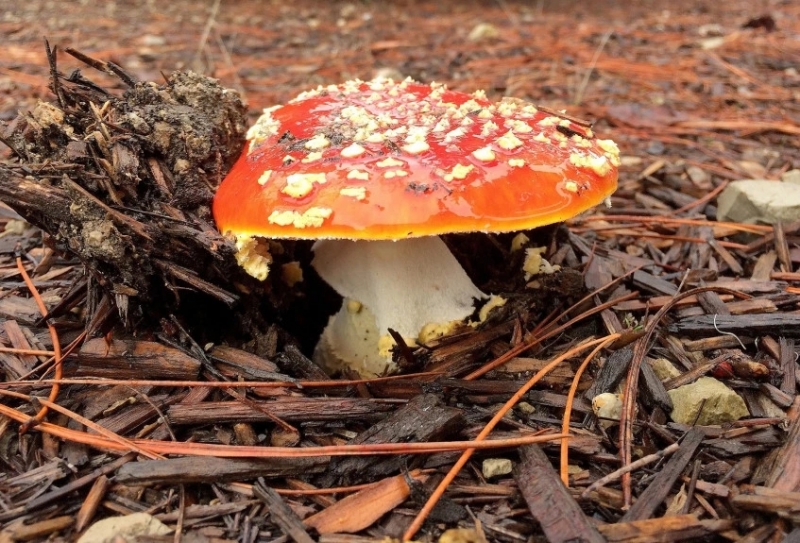
It’s the time of year when frequent rain storms make for perfect conditions for beautiful, delicious edible mushrooms – and their poisonous doppelgängers – to pop up throughout the Monterey Peninsula.
Many wild mushroom species grow in this area, including both edible mushrooms and some toxic species. Wild mushrooms are defined as any fungi that are not grown by commercial growers.
“Some of these mushrooms – to someone who isn’t experienced – may look safe to eat but can actually be harmful,” says Dr. Edward Moreno, Monterey County Health Officer. “Mushrooms that are foraged and harvested should be checked by an expert before consuming.”
According to Moreno, three species in the Amanita genus are responsible for most mushroom poisonings in California: the “death angel” (Amanita ocreata), the “death cap” (Amanita phalloides), and the “fly Amanita” (Amanita muscaria).
These species grow throughout the state during the rainy season and are often mistaken for edible mushrooms. Both the death angel and death cap look harmless, whitish or pale yellow, devoid of the bright colors that often warn of danger in nature. The fly Amanita is the archetypal storybook mushroom, with a vivid red cap and white spots.
Symptoms of ingesting poisonous mushrooms are abdominal pain, cramping, vomiting, and diarrhea, according to Moreno. Severe cases can lead to liver damage or liver failure, comas, or even death.
The California Poison Control System (CPCS) receives more than 700 reports of mushroom ingestion every year. This number can spike in years with heavy rainfall, like in 2016. Mushroom poisoning can be fast-acting and many cases is treatable, though some cases can be fatal.
“It’s important to seek care immediately so health care providers can consult with medical professionals that are familiar with mushroom poisoning,” says Moreno. Anyone who believes they may have ingested toxic mushrooms should seek medical attention or call the California Poison Control immediately.
Ingesting toxic mushrooms also has adverse effects in dogs, according to the June 2012 issue of Pacific Tide, a newsletter produced by Pacific Veterinary Specialists. Dogs that eat some Amanita species in the Monterey area usually exhibit symptoms like vomiting or diarrhea.
However, if the proper precautions are taken, wild mushrooms can be quite fun— in the forest and in the kitchen says John Pisto, a local chef who owned several restaurants throughout the area and often cooks with wild mushrooms.
“It’s the most unbelievable thing, to be walking in a forest after it rains and find something that’s absolutely beautiful, then to harvest it and take it home and cook it,” he says.
Many wet mornings in the Del Monte Forest, mushroom-hunting locals can be spotted through the trees with buckets or shopping bags bulging with mushrooms.
Natalia Mayevskaya was one of those collectors on Thursday. She frequently drives more than two hours from her home near San Francisco to hunt for mushrooms in the rain-soaked soils of Monterey County. She likes to eat the mushrooms she finds— but only the ones she’s familiar with. “If I don’t know what it is, I won’t touch it. I only take the ones I’m really sure of,” she said.
Mayevskaya is a member of an online Facebook group, Mushroom Hunters of California, in which users share photos and help each other identify mushrooms they’ve found in the wild. Groups like the Bay Area Mycological Society or the Fungus Federation of Santa Cruz also have online resources and events to help people safely forage for mushrooms.
Pisto’s advice to those interested in cooking with mushrooms? First, make sure it’s the right mushroom. For those just starting to cook with wild mushrooms, he suggests purchasing from reputable sellers, like Far West Fungi in San Francisco or Untamed Feast in Vancouver, Canada.
Then, experiment. Pisto likes to use wild chanterelles, porcini mushrooms, candy caps, pig’s ear, and oyster mushrooms in his dishes.
“It’s a whole new ball game of flavors and textures,” he says. He especially enjoys cooking with candy cap mushrooms because they impart a distinct flavor – like maple without the sweetness – to desserts or savory dishes. Pisto infuses candy cap mushrooms into caramel sauce, grinds and mixes them into pancakes, or adds them to Italian pasta dishes.
“Luckily, our peninsula is full of mushrooms,” says Pisto. “You won’t believe how many mushrooms are here in Monterey.”
























